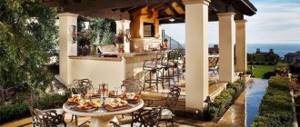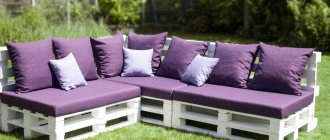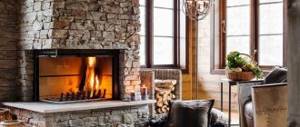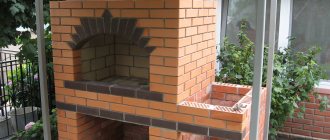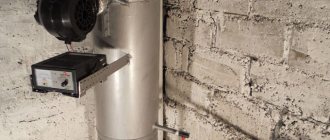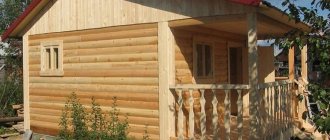Design features
As you know, the main purpose of the stove is to heat the steam room building for a specific time. In order to work with maximum heat transfer, they are equipped with the following design elements:
- The heater is the main attribute of the stove. Its purpose is to maintain a stable flow of heat, which is carried out due to the mass of stones that gain heat from burning wood.
- Chimney. It is presented in the form of a pipe coming out of the firebox and discharging combustion products outside. As a result, wood-burning sauna stoves with a water tank are characterized by low efficiency.
- Door with passage tunnel. Designed to allow the sauna to be heated with wood in the next room, or in the dressing room.
- Heat exchanger. Installed to heat water during combustion.
- The firebox is an area for storing fuel to warm it up; heat energy is immediately released. Often, a grate is mounted in it in different positions, which depend on the type of fuel. For firewood, the grate must be positioned at a level with the door firebox. Bevels are also made on three sides to roll combustion products forward.
- Ash pit. The place under the grate where the ash is located.
Furnace components
The operating principle of wood-burning cast iron sauna stoves
Fuel is added to equipment in several ways. This point depends on the type of wood-burning sauna stove with a water tank. During the combustion of wood, ash and soot are formed. These remaining fuel are poured into the ash pan through the grate. The ash pan is cleaned of soot and ash manually. The chimney is designed to remove gaseous combustion products generated during the burning of wood.
As a result of fuel combustion, heat is released. The heated air is several times lighter than the cold air, so it rises up the stones. The stones heat up, giving off heat to the steam room, where comfortable temperature conditions are formed.
An example of a cast iron sauna stove with a water tank
Wood-burning sauna stoves with a water tank with a remote firebox have the ability to create optimal temperature conditions. In such designs, fuel is loaded into the chamber from the room adjacent to the steam room. The exhaust gases give off heat and the water quickly heats up.
Operating principle of the furnace
Almost all wood-burning heat sources operate according to this principle: first, firewood is placed in the firebox, which heats the equipment, and its walls produce heat transfer. As a result, the room is quickly heated, but at the same time the temperature does not last long, which is why it is necessary to constantly add firewood.
Helpful information! Most often, wood is set on fire from below. Since the fire rises quickly, and in the end only coals remain, it is necessary to add fuel in a timely manner.
Principle of operation
Long-burning heating devices differ from traditional stoves in the possibility of long-term heat transfer without the need to frequently add firewood. The intervals between tosses are about 20 hours. Such furnaces operate on the principle, the peculiarity of which is the reverse direction of the combustion process, that is, from top to bottom.
Construction of a long-burning furnace
Design requirements
The best type of stove for a wood-burning sauna with a water tank is equipment that is easy to use, compact, economical and aesthetically pleasing. It is recommended to use wood and processing as fuel. Here is a list of mandatory requirements that any oven must meet:
- a wide range of heat transfer power, which will be sufficient to heat the bath. It should also be noted that the power for heating may not be enough depending on the type of construction of the steam room;
- the mandatory presence of a steam generator and a heat generator, allowing you to regulate the furnace power;
- built-in convection control devices;
- high-strength coating.
The simplest and most reliable design
Helpful information! If these requirements are met, a wood-burning sauna stove with a water tank will provide excellent heating and proper safety.
There are also requirements for the equipment from a fire safety point of view:
- the presence of a solid foundation made of fireclay bricks or concrete;
- the stove coating should be as smooth as possible;
- the wall for the remote door must be made of non-combustible material;
- the gap between the door and the opposite wall should be at least half a meter;
- the location of the stove should be such that the side walls are at a distance of half a meter from combustible structures;
- the floor near the stove should be finished with fire-resistant material.
Fire protection of structures
Internal tank
Most often you can find brick sauna stoves with a water tank built into the firebox, since the heating unit made of brick is built to order and it is possible to provide space for placing a water heating box. Metal stoves are also equipped with a built-in tank.
The hot water tank is positioned so that it does not have direct contact with the flame in the combustion chamber. When designing a brick stove with a tank, you can provide a dividing wall made of refractory material; the tank is built into the metal unit from the side of the heater and it must be separated from the firebox by a layer of heat-resistant stones at least 20 cm thick.
A stove with a water tank built into the firebox has a number of serious disadvantages
:
- There is no way to control the water level in the tank.
- The water is constantly at the boiling stage - it is necessary to provide a device for removing steam.
- The water in the built-in water heating box boils while the steam room is warming up, long before the air in the room is heated. As a result, the steam room is filled with cold steam, which excessively increases air humidity and makes it difficult to achieve a comfortable temperature. To avoid this, you need to regularly drain some of the hot water and add cold water, lowering the temperature in the container.
- The built-in reservoir must be filled before igniting the stove to prevent cold water from entering the hot metal container. As a result, part of the thermal energy released during fuel combustion is spent on heating water, and the time required to warm up the steam room increases.
- Water from the built-in tank cannot be used for showering - it can only be poured into a substitute container.
- The built-in container is not available for complete cleaning of scale that accumulates during operation.
A brick wood-burning sauna stove with a water tank built into the firebox is inconvenient to use, takes up a lot of space, and requires more fuel to heat the steam room, since part of the energy is spent on heating the water and boiling it. Installing the unit is not cost effective.
Finnish wood-burning sauna stoves with a built-in side tank are equipped with automation, thanks to which the heating of water in the tank and air in the steam room is regulated. This simplifies the use of the unit and eliminates the risk of cold steam formation.
A brick sauna stove with a water tank is equipped with a built-in reservoir. The container can also be installed in cast iron and steel sauna stoves.
Types of wood-burning sauna stoves
Types of wood-burning stoves for baths
Wood-burning sauna stoves with a water tank can be of two types depending on the base material:
- Metal stoves. Cast iron and steel devices are represented in a wide range on the modern construction market. The shape can be rectangular or square. They can be equipped with doors and heating containers. Among the advantages of steel and cast iron stoves, the following are noted: affordable price, simple installation, no need for a powerful base, quick heating of the room, the ability to install the tank on a chimney. Among the disadvantages are the rapid cooling of the stove and instability to temperature changes.
Metal oven
- Brick stoves for a wood-burning sauna with a water tank. Brick devices do not have the disadvantages of metal ones, because they retain heat in the steam room much longer and have a long service life. Their good appearance is especially appreciated.
Brick oven
Brick stove
Brick kiln diagram
Helpful information! Among the disadvantages of the brick option are the high price, complexity of construction and the need for a special foundation. It is also worth noting the need for more fuel.
Tank placement options
Heat exchangers are often made of stainless steel with an enamel coating. The location of the tank is of great importance, here are the main options:
- internal (built into the firebox);
Bath stove "Siberia" with built-in tank
- Mounted (attached to the body);
Wood-burning stove “Varvara” with a hanging tank
- Remote (with heating from the smoke outlet);
Remote tank heated by chimney
- Remote (heated from a mounted tank in the firebox);
Remote tank heated from the firebox
Helpful information! It is not recommended to equip brick stoves with an external tank heated by a chimney, so they are more often found with internal and external heat exchangers.
Popular models of wood stoves with a heat exchanger
This list contains the top most popular wood-burning sauna stoves with a water tank:
- Teplodar "Sahara 10 LB". The equipment is made of steel. Design features: painted convector and remote door with passage tunnel. Designed for heating small rooms measuring 4-10 cubic meters. The design includes a domed heater and a chimney. The combustion is carried out from another room. The advantages of the furnace include resistance to burnout and scale formation. The package includes a mounted heat exchanger with a capacity of 33 liters.
Model range "Sahara"
- Stove-heater "Kolibri 9B". Designed for heating steam rooms for individual use. The package includes a mounted built-in heat exchanger. The equipment is made of stainless steel. Among the features of this model, it is worth noting the ability to produce water steam and hot water at the same time, and control liquid flow. The latter allows you to significantly save water resources during operation. The design features a minimal number of welding seams.
Model "Hummingbird"
Video: review of the Termofor Geyser stove
Types of wood-burning sauna stoves
The purpose of wood-burning sauna stoves is to release as much heat as possible into the steam room within a relatively short period of time. Accordingly, they must constantly operate in maximum heat transfer mode, therefore they differ in some design elements:
- heater;
- direct exhaust of flue gases to the outside;
- remote loading door;
- tank for heating water.
The main attribute of the heat source for a bath is a heater. Its task is to maintain a stable heat flow, which occurs due to the massiveness of a large number of stones that gain heat from the firebox. Another feature is a straight chimney that comes out almost from the firebox and removes combustion products heated to a high temperature to the outside. Because of this, wood stoves release a lot of heat into the atmosphere and are not very efficient.
A remote door with a passage channel is made to increase the convenience of heating the steam room. It makes it possible to load the firebox with firewood from the adjacent room – the dressing room. Well, often a water tank is installed on the stove so that it heats up during the kindling process. Heat sources can be divided into types according to the materials from which they are made or laid out:
- metal (steel and cast iron);
- brick.
Steel and cast iron wood-burning stoves are offered on the modern market in a wide range. They come in round and rectangular shapes, with a door equipped with panoramic glass and heating containers of various types. Brick stoves are no worse in this regard, since the same options can be provided during construction. Sauna cast iron and steel stoves have the following advantages:
- reasonable cost;
- simplified installation, does not require a strong base (foundation);
- quick heating of the heater and steam room;
- the ability to place water tanks on the chimney, preventing heat from going to waste.
True, such heat sources cool down as quickly as they heat up. In addition, cast iron products are afraid of sudden temperature changes from cold water hitting a hot surface. Brick stoves do not have such disadvantages; they retain heat for a long time and last as long as the building itself costs. Stoves built from brick are distinguished by their special appearance and quality factor.
Among the disadvantages of brick stoves for baths, it should be noted their high cost due to difficulties with construction and the need to construct a foundation. The duration of heating the steam room with a similar heat source also plays a role, which will require more fuel. On the other hand, brick structures retain heat much longer than stoves made of steel or cast iron.
Step-by-step construction of a brick oven with your own hands
The first stage of building a brick kiln is the foundation. The base for a wood-burning brick stove for a bathhouse with a water tank must be especially strong. It is done this way:
- dig a hole 3 meters deep and compact the soil;
- cover it with a 100 mm layer of crushed stone and sand;
- make wooden formwork and reinforcement;
- pour concrete mixture 1 meter thick;
- let stand until hardened for about 3 weeks.
Foundation preparation
The furnace is laid using clay mortar. The bricks are laid in compliance with the chosen order, leaving a seam no more than 5 mm thick. It is recommended to build the base of the firebox from fireclay bricks. In order not to delay construction, it is better to first stock up on doors, valves, grates and a water register.
Masonry options
Furnace laying and arrangement of structural elements
Related article:
Finishing the bathhouse inside. Photos and examples. In a separate publication you will find interesting ideas for decorating steam rooms and relaxation rooms, and also learn the main stages of installation.
How to install brick ovens with a water tank
Brick sauna stoves with a water tank can have different designs. The general thing is that the tank is located either above the firebox or on the side of it, next to the heater. a protrusion of appropriate size is made under the tank, which has a rectangular shape .
For independent work on the construction of a brick kiln, you need experience . The “recipe” may seem simple, but this simplicity is deceptive. Read more about brick kilns here.
It all starts with choosing a design , and there are quite a few of them. When the choice is made and the orders are found (for example, on the Internet), the number of bricks and the weight of the stove with all its components are calculated - the depth of the foundation depends on this parameter. If the weight of the finished stove is more than 700 kg (and it will definitely be more and do not forget to include a tank filled to the top with water), then a foundation is automatically required . Read about how foundations for furnaces are made on our website.
Having prepared the base, you can begin laying. But first you need to prepare the right solution .
First you need to soak the clay. To do this, take equal amounts of water and clay and mix them. After a couple of days, wipe the solution through a fine grid (3x3 mm is good). Then take the sand , sift it and add it to the mixture so that you get something like thick sour cream. The masonry mortar should be neither too fat nor too thin.
Alternatively, you can buy a ready-made clay-sand mixture in bags at a hardware store; just dilute it with water and you can lay the stove (follow the instructions on the bag).
The masonry itself follows the order of the chosen furnace design . You will need two types of bricks: regular solid and fireclay . To help those who decide to do it themselves, we have selected a video where the essential nuances are explained (the voice is boring, but you can be patient):
We also recommend useful materials about stoves:
Well, the topic is covered sufficiently fully so that you can decide on the choice of the right type of tank, its volume and location. Good luck with the installation!
Many people who have a dacha or a country plot dream of having their own bathhouse. After all, it has long been known for its healing, invigorating effect. Sauna stoves with a water tank are extremely popular and, in fact, are the basis of traditional construction. It's not very easy to install, but it's worth the effort. Let's consider in more detail: the principles of the design and operation of these stoves, their types according to the material and location of the tank, what parameters to choose a stove for, several popular models, how to make a stove yourself.
Contents of this article
Tips for choosing
When choosing a metal stove, you need to consider the following points:
- thermal power. Here you need to immediately calculate the area of the room. And taking into account the area, you can select the power of the furnace; one cubic meter is equal to one power;
- container for water. When choosing a container, consider the volume and method of its location. Experts recommend a mounted and remote tank with a volume of 50 liters or more.
Characteristics of tanks for a metal furnace
It is much easier to buy a metal version of a wood-burning stove for a bathhouse with a water tank and install it with a remote firebox. A brick oven will be much more expensive and more difficult to build. But the service life and quality of the firebox is better in the brick version of heating the steam room.
Types of heating water tanks
As a rule, containers for preparing hot water are made of stainless or carbon steel coated with enamel. In this regard, the location of the water tank plays an important role, and it can be as follows:
- built into the firebox (internal);
- hinged, attached to the body;
- external, heated from the chimney;
- remote, with heating from a heat exchanger built into the firebox.
Note. It is difficult to install the tank in brick kilns on the chimney, so internal, mounted and remote tanks with a heat exchanger are used.
A metal vessel for hot water, built into the firebox or hung outside, is one of the worst options. In the first case, it is impossible to control the water level; in addition, it constantly boils, which requires the organization of steam removal. The big inconvenience of a hanging tank is that boiling in it begins much earlier than the steam room is heated. As a result, so-called cold steam is released, which only leads to an increase in humidity. Such conditions in the bathhouse are absolutely uncomfortable and unacceptable.
There is another serious drawback that speaks against attached tanks. Since water must be present in it initially, when the firebox is ignited, part of the heat released when burning wood goes to heating it. Instead of going to the bathhouse to steam, we wait until the water heats up; the heating time of the steam room increases. In addition, when the water boils, you need to drain it from the tank and add cold water, otherwise steam formation will begin, as mentioned above.
Another thing is a stove with an external tank, heated by the firebox or chimney pipe. Option one: a coil with two pipes going outside is installed inside the firebox of a brick or metal stove. They are joined by a remote container located no further than 3 m from the heat source, since the circulation in the circuit will be natural. It is suspended from the wall inside or outside the steam room above the level of the combustion chamber.
For reference. In some cases, a remote tank is even installed in the attic of a building.
This method allows you to control the water level, its temperature, and also makes it possible to attach a mixer or shower to the tank. True, one drawback remains: thermal energy is taken away from the firebox during heating, since it is strictly not recommended to pour water into the system after heating the bathhouse. Due to sudden cooling, boiling will occur in the hot tubes of the register, followed by water hammer and destruction of the heat exchanger.
The best option is a wood-burning sauna stove with a water tank that takes away the energy of the flue gases. Since the latter are characterized by a high temperature, it would be a sin not to lower it by removing heat for the needs of the hot water supply from the gas duct. The heating process is implemented in two ways:
- a large-capacity tank is built directly into the chimney, the water is heated directly from combustion products;
- on the chimney pipe there is a small tank with two pipes, into which a large remote tank is connected (this is how boiler plant economizers are designed).
Removing the heat from combustion products is the best way to heat water, so the energy from burning wood is used more efficiently and does not go down the drain. The time it takes to heat a stove for a Russian bath does not increase, and some fuel savings occur.
